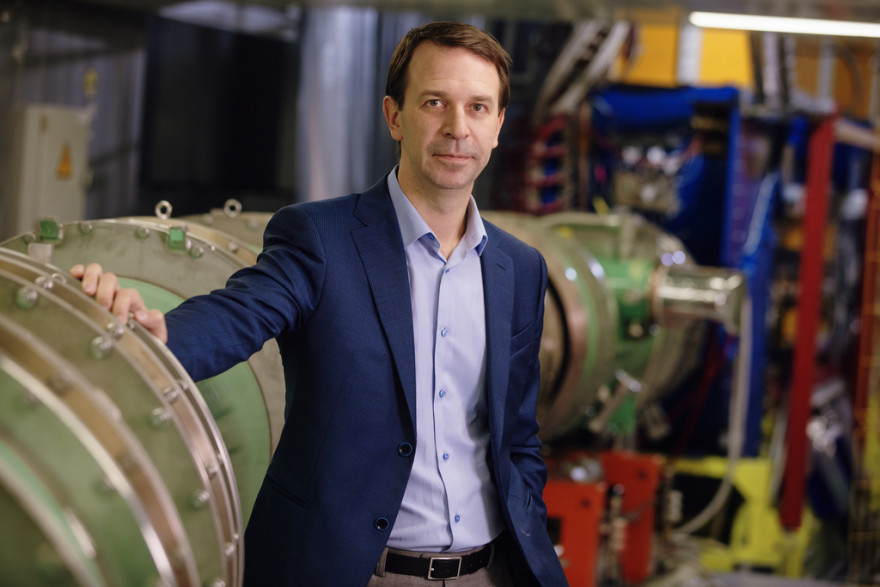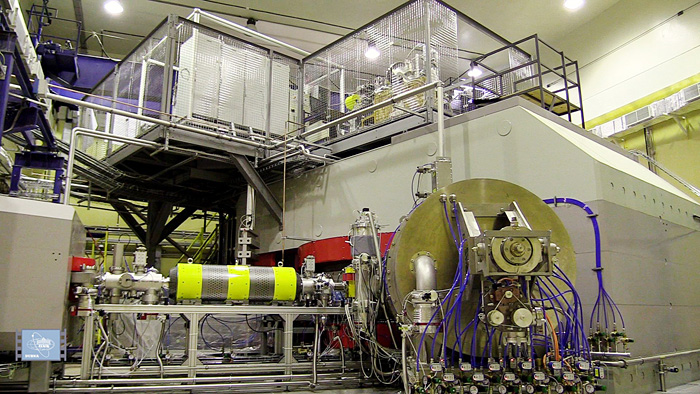Joint Nuclear Prospects: JINR Director Academician Grigory Trubnikov spoke about Institute’s plans
Interview, 29 March 2021
We offer you an interview with JINR Director Academician Grigory Trubnikov, published in the popular science e-journal “Scientific Russia” for the 65th anniversary of JINR. The anniversary series also includes an interview with JINR Scientific Leader RAS Academician Victor Matveev and an interview with JINR Vice-Director Corresponding Member of RAS Vladimir Kekelidze.
 JINR Director RAS Academician Grigory Trubnikov. Photo © Scientific Russia
JINR Director RAS Academician Grigory Trubnikov. Photo © Scientific Russia
Attracting new partners, projects of the Year of Science and Technology, plans for synthesizing new elements: the Director of the international scientific centre spoke about the plans on the anniversary of the Joint Institute for Nuclear Research
Grigory Trubnikov was elected Director of the Joint Institute for Nuclear Research on 1 January 2021. In a talk on the 65th anniversary of the Institute, he recalled how the scientific centre developed and what prospects are ahead of it for the next decade.
– 65 years is in many ways a considerable period. And what does this time period mean for the science centre?
– In 1956, representatives of 11 countries signed our Charter, the decision to establish the Institute, in the Presidium of the Academy of Sciences of the Soviet Union. The Chairman of the Scientific Council of the Institute at that time was Nobel Prize laureate and representative of the GDR, physicist Gustav Hertz. The level set from the very beginning by the founding scientists of the Joint Institute for Nuclear Research is our foundation. Over 65 years, it has been consolidated and enabled us to build a large international intergovernmental research organization.
The Institute has expanded its geography and presence on different continents: we now have more than 900 partner organizations from 64 countries. I suppose you could compare us to a big spreading strong tree: let it be a cedar. And over time, our concentric rings are strengthened with new flags, new names of universities and scientific organizations.
We are now actively involved in North and South America: Mexico joined the NICA project the year before last. This year, we are discussing cooperation and the expansion of cooperation with Chile and Brazil. This is a source of pride for our multinational team and the governments of the Member States.
– The JINR anniversary coincided with the Year of Science and Technology in Russia. How are the activities of the Institute presented in the calendar?
– The motivation for the Year of Science and Technology is to encourage interest in science, to involve civil society in what science does. And to explain its value and role in the development of mankind in a more understandable way. This is a good opportunity for scientific organizations, the Russian Academy of Sciences, and the high-tech industry to highlight its achievements.
The Year of Science and Technology in Russia includes a plan for a range of different events. There’s the laying of two new research vessels for the world ocean exploration programme. The launch of the PIС neutron source in Gatchina: in February, Kurchatov Institute demonstrated a huge facility that is in demand not only by physicists but also by biologists, chemists, and power engineers. It is a kind of interdisciplinary scientific facility. Forums and congresses are held for young scientists and project leaders. The Russian Academy of Sciences plays a key role in the Year.
And our Institute is, of course, involved in the events. We speak with gratitude about Russia as the host country of our сentre. Russia has provided exceptional conditions and opportunities in Dubna for a large international family of dozens of countries and hundreds of people to work comfortably, productively, and exclusively on ambitious tasks.
The first event in the Year of Science and Technology is the launch of the neutrino telescope at Baikal. Several dozen people are now installing new clusters of the deep underwater telescope on the ice of the lake, and experiments and first data collection will begin in early April. The facility will be the largest neutrino telescope in the Northern Hemisphere.
The second event we are preparing is the launch of the second cascade of the NICA superconducting collider. This stage is scheduled for December, the end of the Year of Science and Technology. I hope that in addition to the technological and power launch of this complex, we will also finally start working for physicists: working with high-energy heavy ion beams in a spectrum unavailable in any laboratory in the world. They have been waiting almost a year and a half to complete the assembly of the superconducting rings and channels and to test all the systems. Fourteen countries, more than 350 people are working on the experiment.
I should also recall the success of 2019. The experiment to discover short-range correlations in the carbon nucleus was conducted at the NICA complex, during 2020 the data were analysed and processed, international expertise was conducted. At the end of last year, the journal Nature accepted a paper with the results of the experiment. This is probably the most prestigious journal when it comes to the natural sciences.
– NICA, the Baikal telescope, and the Superheavy Element Factory are now prominent projects. Is it possible to announce new global projects in the anniversary year?
– The anniversary and the Year of Science and Technology are perfect information sites for scientists. To talk about perspectives, to announce plans, is, in fact, to involve new partners in our programme. The United Nations has declared next year the International Year of Basic Sciences for Sustainable Development. It seems symbolic that Russia, having hosted the Year of Science and Technology, is passing the baton to UNESCO. JINR is one of the key partners of the International Year of Basic Sciences.
 Superheavy Element Factory: accelerator DC-280. Image by JINR
Superheavy Element Factory: accelerator DC-280. Image by JINR
Events are now intriguingly developing at the Flerov Laboratory of Nuclear Reactions where superheavy elements are being synthesised. During the month of the Factory’s operation in January, we received about 60 chains of super-heavy moscovium (MC 115). The Factory is now producing five events a day. In a month of the operation in the Laboratory, we have synthesized twice as many superheavy elements as in the previous 8 years of experiments. Scientific Leader of the Laboratory Yuri Tsolakovich Oganessian said that now the Factory is operating at one third of its capacity. In this field, we are about 10-15 years ahead of laboratories in Japan, Germany, and the USA.
At the end of the year, we will start preparing and conducting experiments on the synthesis of new elements in the eighth period of the periodic table: elements 119, 120, and possibly 121. We are discussing with American colleagues their contribution to the research, namelyequipment that will arrive in the second half of this year. American universities are getting involved, and one of the reactors at Oak Ridge National Laboratory is creating targets for our experiments on the synthesis of elements 119 and 120.
We are now working with a beam of doubly-magic calcium-48 nuclei, but we need heavier nuclei with more neutrons to synthesize the next elements. Chromium and titanium may be used. Together with our partners from the French Institute for Nuclear Physics, we have worked out the technology to create them, and we hope to have the new sources up and running in the laboratory by the end of the year.
These are plans for two or three years. But we are also thinking about what will happen in 2035, 2040.
We are now actively discussing the creation of an brand-new generation neutron source, which will replace the existing IBR-2 reactor. Jointly with our colleagues from Rosatom, we have started to design it.The work will take 10-12 years because it is a nuclear energy facility, there are difficult stages to go through in developing all the components, primarily nuclear safety. It is one of the bright stars we aim for by 2035.
We are actively entering the digital realm. In the world’s top 500 ranking, our computer cluster is number 17 in terms of a set of factors: storage, processing, transmission of data arrays, analysis and bandwidth. We have provided computing power to the World Health Organization to process data on coronavirus analysis and spread statistics. This is our participation in a global initiative.
When it comes to the computer cluster, we are primarily looking at quantum technology. But we are not interested in hardware. The race of quantum computers began few years ago, and it makes no sense to be catching up now: we need to be ahead without catching up, and we are betting on creating quantum algorithms. That is mathematics that is needed not only for cryptography, in which quantum computers are now used, but for other tasks as well. They may sound fantastic so far. For example,modelling new materials, high-temperature superconducting alloys, artificial cognition in non-binarylogic, data transmission using elementary particles, and so on.
With colleagues from France, Germany, the USA, and Israel, we are now working on a quantum algorithm to calculate the limits of the periodic table: where is the limit to the existence of nuclei, the nuclear matter we are made of? There is the periodic law, there is the periodic table. Humankind is unlikely to advance beyond element 121 in the next 10 years, but it is believed that the boundaries of the table lie at the level of the element with the number around 170. And what’s beyond that: is our world stable? In what form can nuclear matter exist further, until when is it stable?
We are actively raising the flag for research on life sciences. We have already started designing an interlaboratory innovation cluster for research in radiobiology. This is radiotherapy, i.e. the treatment of cancer with beams of charged particles. It is radiobiological research in the fields of neurodegenerative processes and understanding the mechanisms of diseases such as Parkinson’s, Alzheimer’s, dementia. Our international radiobiological programme includes the most advanced OMICS technologies: genomics, metabolomics, proteomics. There is now an understanding and our first joint results with medical professionals that the combined use of pharmaceuticals and radiation can make medicine more effective.